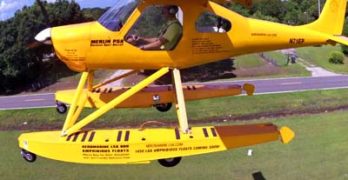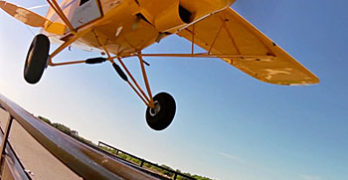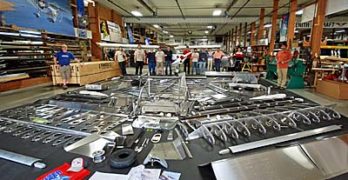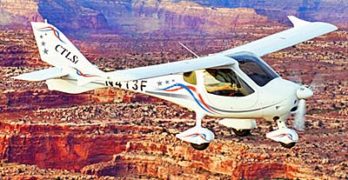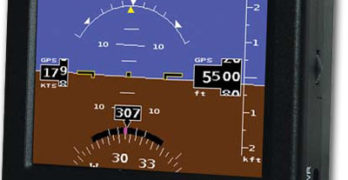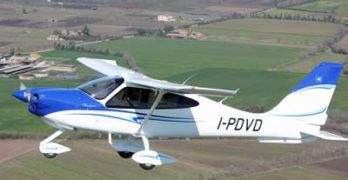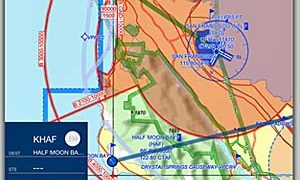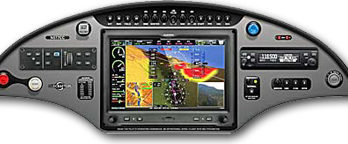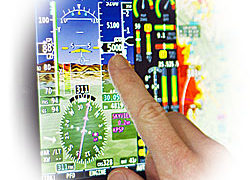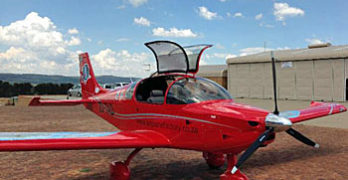It’s summer. It’s hot. The water beckons. Yet, you’re a pilot. How do you enjoy both? Get a seaplane, preferably a Light-Sport or light kit seaplane. You have several choices. The trouble is that any seaplane is priced well above landplanes of similar configuration. Some LSA seaplanes smash through the $200,000 barrier. That may represent a fair value for what you get but it exceeds the budget of many recreational pilots. How about $55,000 to $65,000? That sounds better, doesn’t it?
Runway testing and cross country trials of the float-equipped Merlin PSA is complete. Aeromarine LSA owner Chip Erwin reports performing stalls, turns, climb, and cruise tests, each of which passed his criteria, although he continues in trials. The floatplane Merlin has not yet entered the water but that will happen in days after Chip finishes his initial wringing out of the float version. These floats are amphibious so land trials made sense at first.
Search Results for : IFR
Not finding exactly what you expected? Try our advanced search option.
Select a manufacturer to go straight to all our content about that manufacturer.
Select an aircraft model to go straight to all our content about that model.
Greg Koontz’s Crazy Flying Act in Titan Legend
Probably you’ve seen an act like this before. A crazy-acting farmer or a supposed drunk hops into a Piper Cub or similar aircraft after the regular pilot leaves it unattended for a few minutes. The crazy guy has no flying experience but somehow proceeds to start up the airplane and to take off in the most out-of-control manner imaginable. As he erratically careens around the sky, handling the aircraft wickedly out of control, he nearly impacts the ground over and over. The entire act takes place within a couple hundred feet of a hard-as-concrete surface.
Even though it’s only an act and even if the pilot is actually a gifted aviator, it’s easy to get caught up in the moment and fear that nutjob is going to whack the airplane into the ground right in front of the airshow crowd watching in fascination.
So, you may look at the act Greg Koontz performs and you might undervalue the skill involved.
Cruzer Prepared for FAA Kit Evaluation Team
Even very familiar companies like Zenith Aircraft company, part of a family light aviation empire including Zenair in Canada•, has to prepare well when FAA comes to visit. Specifically, this would be the agency’s KET or Kit Evaluation Team. When various representatives of the regulatory agency visit they use a multi-page list to assure that a kit aircraft meets the requirement that 51% of the kit is built by the owner.
Formerly called Experimental Amateur Built (or EAB), many aviators simply say the “51% rule.” In earlier times, kit aircraft were scratch built — meaning a builder secured raw materials that had to be formed and finished while referring to drawings, a potentially very lengthy process. To ease the effort and increase sales, an industry developed to sell component kits. These have become increasingly sophisticated with qualities such as match-hole construction using CNC machines.
Making it easier for a builder to assemble his or her aircraft is good, but the kit manufacturer must be able to clearly demonstrate how the owner will do 51% of the work, as required.
6 Questions about Third Class Medical Reform
EAA’s top e-Hotline story last week was, “The Senate Committee on Commerce, Science and Transportation on Wednesday passed S. 571, better known as the Pilot’s Bill of Rights 2 (PBOR2), bringing significant third-class medical reform one big step closer to reality.”
This week AOPA reported PBOR2 passed the Senate and is en route to the House.
This represents progress that many EAA and AOPA members sought, so smiles all around at the big member organizations.
PBOR2 must still pass the House and be signed by the president. Note that this is already the second attempt — hence the “2” — as an earlier version met resistance. Concessions had to be made to advance the proposed regulation. Even if it passes the House and is signed, it will take perhaps one year for FAA rulemaking.
It seems like everyone is on board. Why such a long delay?
Organizations like the Airline Pilots Association have come out against this proposed law and will probably continue to speak out against it.
Dynon’s “Pocket” EFIS Now Has a Lower Price
If you love Light-Sport Aircraft or light kit aircraft, odds are you love Dynon Avionics. This company, almost single-handedly, changed the game of glass cockpits for airplanes that cost a a fraction of most new general aviation aircraft. The company has acted like a Silicon Valley tech company meaning that it moves at Internet speed. Other avionics companies have been challenged to keep up with the Dynon dynamo.
Based in Woodinville, Washington, Dynon Avionics began business in January of 2000 with the development of the D10 EFIS, which began shipping in March 2003 to a warm reception. One of the cool early installations of a D10 system was on the Space Ship One, the first private aircraft to reach outer space. The company was founded John Torode, a former tech executive and a pilot who keeps a couple seaplanes docked in front of his home on Lake Washington.
Get Ready for 2010 … the Plane (not the Year)
Tecnam has become widely known for its extensive fleet of Light-Sport Aircraft designs (meeting ASTM standards) and for their popular twin-Rotax 912 Twin model (using traditional certification). At Sun ‘n Fun 2015, visitors can expect to lay eyes on the P2010 or as Tecnam usually calls it, “P Twenty Ten.”
I have told you that ByDanJohnson.com expects to cover Light GA Aircraft — or LSA 4.0, as my journalist pal Marino Boric christened them — in addition to our on-going coverage of Light-Sport Aircraft, light kit-built aircraft, and ultralights including microlights and electric-powered aircraft. You can hardly miss the theme: “light” aircraft but the coverage is meant to be of affordable aircraft brands this website often covers — and is supported by — including all American and international producers of LSA.
As you look at the photos in this article and compare them with the P2008 (bottom photo), you see the resemblance clearly.
Jeppesen’s VFR App Is Developing Rapidly
For most of the years I have been flying, we (in the USA) had NOAA aviation charts and Jeppesen Sanderson charts. Other companies supplied maps and charts as well, but NOAA and Jepp dominated. The National Oceanic and Atmospheric Administration aeronautical charts were published by NOAA’s National Ocean Service until publication was taken over by FAA in October 2000, coincidentally the same year Jeppesen was acquired by Boeing. NOAA charts were cheaper but a large measure of pilots felt Jepp charts were superior. For many years Jeppesen has served four market segments: airlines, business aviation, general aviation, and the military. The Colorado-based enterprise is celebrating its 80th anniversary since Varney Airlines pilot Elrey Jeppesen made the first aeronautical charts to navigate in flight in 1934. For more on the company’s long history, see Wikipedia’s entry.
Jepp charts were king for decades until the digital revolution disrupted many things in life … from cameras and taking photos to electronic communications to widespread GPS use to HD television, and much more.
Garmin Goes Touch with New G3X Avionics
For a billion-dollar, publicly-listed company Garmin (stock symbol: GRMN) has repeatedly displayed the nimbleness of a start-up enterprise. As if to prove this point Garmin announced several new products for the start of Sun ‘n Fun. And for those of us who need some introduction to these new gee-whiz gizmos, the company has a seminar tent just north of Hangar D where you can learn it all from the experts. No wonder Garmin remains one of the most trusted names in aviation. (My trusty auto Garmin will be leading me around the winding roads of Europe as we head over to Aero immediately following Sun ‘n Fun.) So … G3X Touch, now in a giant 10.6 display • GTR 20 remote comm controlled through the touchscreen • Angle of Attack (AoA) info when paired with their GSU 25 ADAHRS and GAP 26 probe • and, you can even watch VIRB (Garmin’s HD action camera) video in a PFD inset.
Dynon’s Modernized SkyView Touch
With the chance to fly and learn both Dynon SkyView and Garmin 796, I have become a fan of each. Dynon is dominant in Light-Sport Aircraft instrument panels for very good reasons. They work well and don’t cost an arm and a leg. Their Synthetic Vision is superb. However, much as I have come to love those big, beautiful, all-color digital instruments, you must resort to a button or joystick to make changes. Those of us spoiled by our smartphones and iPads have become accustomed to touch. So, no wonder that I also fell in love with the all-touch 796. It works a lot like my iPad and finding things is reasonably easy … a few functions are hidden behind menu layers but on whole, the 796 is a brilliant bit of engineering design. However, in bumpy air, I’ve had to learn a technique of hanging a thumb or finger on the bezel to steady my hand as I try to select certain functions by touch.
LSA Alive & Well: Slings in Stock; Evektor Sales
The Great Recession was the pits … for nearly all industries and most employees or small business owners. That’s hardly newsworthy. However, the recovery from the recession — that government economists insist ended years ago — has been a long time coming. For too many out-of-work pilots, that recession lingers with us yet. Fortunately, the aviation economy appears to be improving. Although registrations didn’t show it for 2013, the year provided more sales for sellers if not more airplanes for their customers. Now, the hope is that airplanes will emerge from factories faster and the general health of the industry will improve, which is good for seller and buyer alike. A couple companies have proof that things are looking up and I’d like to tell you a little about them.
First is South Africa’s The Airplane Factory (TAF) and their rep’, TAF USA, led by Matt Litnaitzky and associate Ryan Ruel.
- « Previous Page
- 1
- …
- 42
- 43
- 44
- 45
- 46
- …
- 48
- Next Page »


